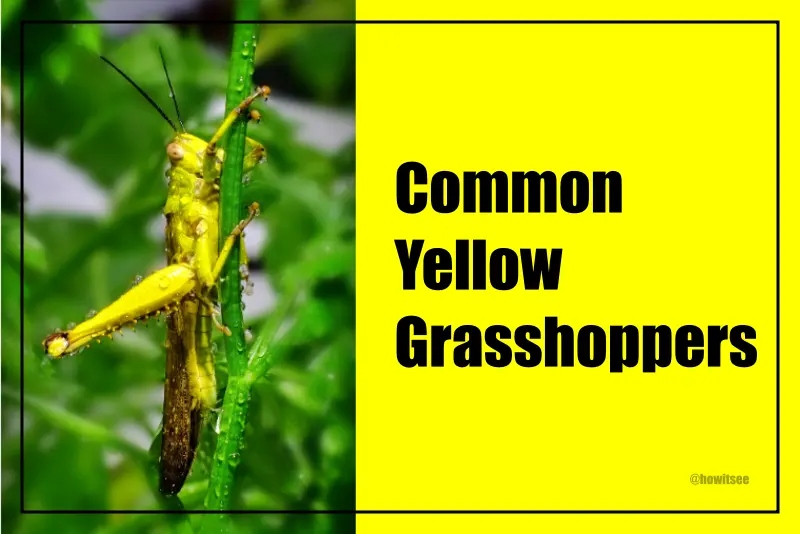Yellow Grasshopper is an interesting species found in nature. Though yellow is not a common color found in nature. These are unique kinds of species that use their yellow for adaptation to the environment. In this article we are going to talk about these grasshoppers found with yellow bodies or wings.
How much do Common Yellow Grasshoppers Eat in a Day?
The amount of food consumed by common yellow grasshoppers in a day can vary depending on various factors such as size, age, and environmental conditions. On average, a grasshopper can consume 16 times its weight.
However keep in mind that this is a general estimate and individual grasshoppers may consume more or less depending on factors such as food availability and energy requirements.
10 Common Yellow Grasshoppers
1) Differential Grasshopper

| Scientific Name | Melanoplus differential |
| Size | 28-50mm |
| Location | Northern Mexico, the United States, and Canada |
| Identification | This grasshopper has a pale yellow body |
The differential grasshopper is known for its yellow coloration. It is a beautiful insect found in many grasslands and meadows. The sunny hue of this creature makes it possible for it to camouflage itself effortlessly among the golden foliage in its habitat. This makes it a perfect match for its surroundings.
The yellow pigmentation of its exoskeleton not only aids in concealment from predators but also plays a role in thermoregulation. By absorbing sunlight, the differential grasshopper can warm its body, thus, optimizing its metabolic activity and enhancing its overall agility.
This special form of adaptation showcases nature’s remarkable ability to create striking adaptations that benefit a species in multiple ways.
2) Eastern Lubber Grasshopper
| Scientific Name | Romalea microptera |
| Size | 43-70mm |
| Location | United States |
| Identification | It has a yellow body with red and black spots |
On this list we have another grasshopper called the eastern lubber grasshopper, which is a captivating insect frequently seen in the southeastern United States, hence the name.
The Potential predators are warned by the exoskeleton’s bright yellow color as it makes the creature unappealing and harmful.
Its appearance is enhanced further by the contrast between its black and red patterns, which improves its the defense mechanism known as aposematism.
The eastern lubber grasshopper’s bright yellow hue serves as a visual barrier, keeping predators away from trying to eat it.
It’s brilliant colors are frequently used as warning signs in nature. This particular adaption shows how the grasshopper can defend itself by flashing a brilliant and vivid warning.
3) Yellow Zebra Grasshopper
| Scientific Name | Zebratula flavonigra |
| Size | No information |
| Location | No information |
| Identification | It has a zebra-like appearance with black stripes on yellow body |
Further on this list is the yellow zebra grasshopper which is technically known as Zebratula flavonigra. It is an enthralling bug which is distinguished by its bright yellow color.
This grasshopper species has a bright yellow exoskeleton with complex black stripes resembling the stripes of a zebra. This yellow color serves several functions in this grasshopper’s existence. It serves as camouflage which helps the insect to blend in with its grassy surroundings easily.
The yellow color also aids thermoregulation by absorbing sunlight, warming the grasshopper’s body, and thus, boosting its metabolic activities.
Furthermore, the brilliant yellow color may also act as a visual signal to other individuals of the same species, communicating essential information such as mating readiness or territorial borders. The stunning look of the yellow zebra grasshopper shows nature’s diversity.
4) Horse Lubber Grasshopper
| Scientific Name | Taeniopoda eques |
| Size | 6-8cm |
| Location | Southwestern United States and Northern Mexico |
| Identification | It has black body with yellow lines |
One interesting name on the list is the horse lubber grasshopper, or Taeniopoda eques as it is scientifically known. It is an interesting bug that fascinates with its distinctive traits. This species has striking red and black markings contrasted with a beautiful yellow coloring web-like design.
The exoskeleton of this grasshopper acts as a warning sign to its potential predators and confuses them due to its beautiful, striking bright yellow color. This coloration is called aposematism, which usually keeps away predators that think vivid colors are harmful or repulsive.
The horse lubber grasshopper’s yellow color not only enhances its appeal but also serves as a form of protection which makes it a stunning sight in grasslands and open settings.
The colour of this grasshopper illustrates the complex survival mechanisms that is used by nature and illustrates the unmatched variety of the insect kingdom.
5) Painted Grasshopper
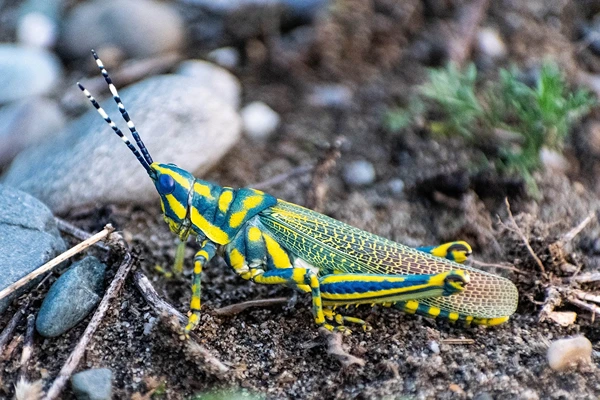
| Scientific Name | Poekilocerus pictus |
| Size | 60mm |
| Location | Indian Subcontinent |
| Identification | It has a yellow body with blue stripes |
Poekilocerus pictus, the painted grasshopper’s scientific name, is a fascinating bug that is native to areas of Asia, particularly India. The intriguing and brilliant look of this grasshopper, which resembles a multicolored piece of art, gives it its name.
A magnificent visual display is produced by the pattern of contrasting blue and yellow colors that cover its body. Its appearance is remarkable, but it also acts as a barrier against attack.
Potential predators are warned by the grasshopper’s vivid colors that it can be poisonous or repulsive. The painted grasshopper is a skilled jumper, moving through the air with agility on the strength of its powerful hind legs. It feeds on a range of plants as a herbivore.
6) Javanese Grasshopper
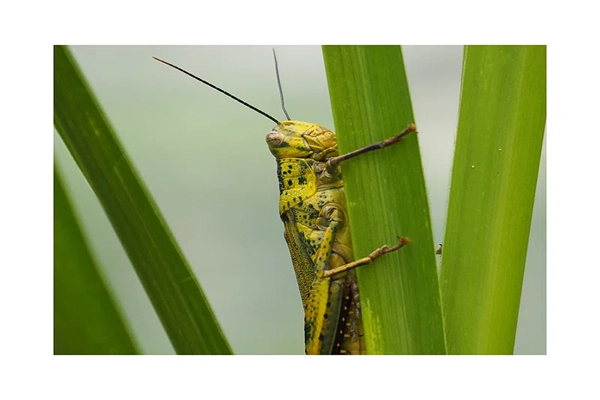
| Scientific Name | Valanga nigricornis |
| Size | 45-75mm |
| Location | Java, Indonesia |
| Identification | It has a yellow body with black spots |
The Javanese Grasshopper, scientifically called Valanga nigricornis, shows an amazing blend of hues with a mostly yellow-green colored exoskeleton.
Because of this, the Javanese Grasshopper may efficiently avoid predators by camouflaging in with the thick greenery of its habitat in Java, hence the name.
It has very strong jumping skills, which help this species’ in survival and also, in foraging activities. The Javanese Grasshopper can quickly move around to collect food and avoid danger from its predators, due to its to its skillfully developed legs and wings.
By eating a variety of plants, these grasshoppers help maintain the ecosystem’s natural balance in the area. The Javanese Grasshopper is a fascinating subject because it represents the amazing variety and adaptability found in the insect world.
7) Spotted Bird Grasshopper
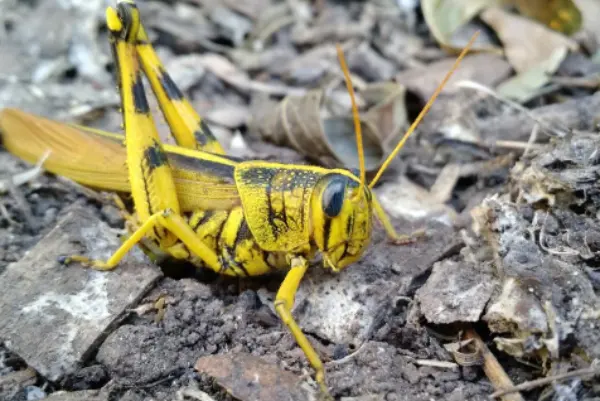
| Scientific Name | Schistocerca lineata |
| Size | 27-51mm |
| Location | North America |
| Identification | This grasshopper has a bright yellow body with black markings. |
On this list at 7th position, we have the Spotted Bird Grasshopper (Schistocerca lineata) which is another fascinating bug species.
Spotted Bird Grasshoppers are one of the most beautiful grasshoppers with bright yellow color and black patterns. The yellow color shade in the body has several functions in the its life.
It helps in camouflage, which allows the insect to fit into its natural environment, such as grasslands or open fields with yellow plants and keep away from predators by making it more difficult to notice.
Apart from this, the other function is yellow color may act as a signal to other members of its grasshoppers, usually to attract other grasshoppers.
Spotted Bird Grasshoppers have distinct habitats including dry grasslands, sandy soils, and forest areas. They are omnivores and feed on both animal tissues and plants’ parts.
8) Yellow Winged Grasshopper

| Scientific Name | Gastrimargus musicus |
| Size | 25-50mm |
| Location | Australia |
| Identification | It has brown body with bright yellow wings |
Another fascinating bug species on this list is the yellow-winged grasshopper, or Gastrimargus musicus , that stands out because of its bright yellow wings.
This species of grasshopper has very distinctive coloring, with its wings covered in various tones of yellow ranging from light to dark.
The yellow-winged grasshopper has several uses for its yellow wings. Mainly, it gives a visual signal that potentially tells important information to other members of its species.
The grasshopper may also use these beautiful yellow wings to scare away potential predators by giving the illusion that it is dangerous and also, to attract mates. The yellow color of this grasshopper, absorbs sunlight that aids in warming up to regulate body temperature.
9) Two stripped Grasshopper
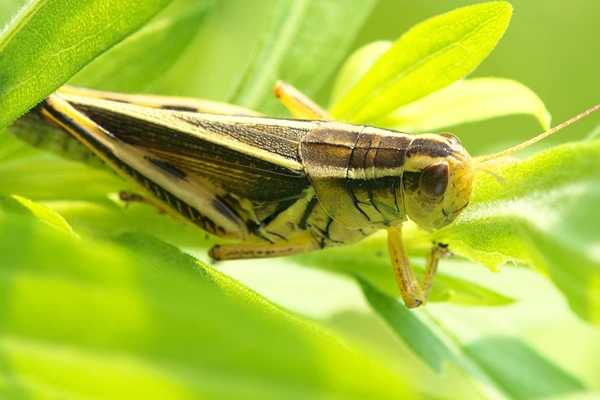
| Scientific Name | Melanoplus bivittatus |
| Size | 55mm |
| Location | Canada |
| Identification | It has green body with yellow and black strips |
The fascinating two-striped grasshopper scientifically known as Melanoplus bivittatus gets its name from the significant yellow stripes that cover its body.
This particular type of grasshopper has a striking yellow colour and two longitudinal stripes that run parallel across its body.
The grasshopper uses these yellow stripes for a variety of purposes. First of all, they serve as a kind of camouflage that enables the insect to hide perfectly with its grassy or leafy surroundings.
The yellow stripes effectively hide the animal from possible predators by resembling the sun-dappled patches and patterns seen in its native habitat. The yellow stripes might also act as a visual signal for other grasshoppers species identification.
10) Desert Locust
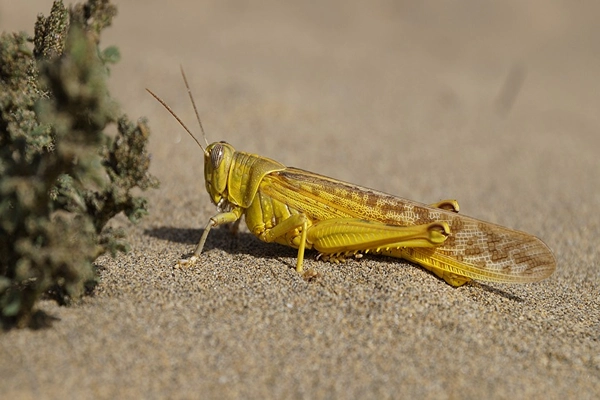
| Scientific Name | Schistocerca gregaria |
| Size | 72mm |
| Location | Africa and middle east Asia |
| Identification | It has a yellow body with black markings |
Last on the list we have the Desert Locust, scientifically known as Schistocerca gregaria, is an interesting bug with a golden body. This species of grasshopper has a yellow body that is enhanced with brown and green colors.
The Desert Locust’s yellow color serves various functions. For starters, it serves as camouflage, allowing the locust to fit in the desert terrain it inhabits. The sandy yellows closely resemble the colors of the desert, offering great hiding from both predators and prey.
Furthermore, the yellow coloring may help with regulation in temperature. The yellow body of the Desert Locust absorbs sunlight, which helps to warm its body in the cold desert mornings and optimizes its metabolic activity.
In conclusion, we can see that the yellow color of grasshoppers help them to hide from the predators in their surroundings. Yellow grasshoppers are considered unique as it is not a common color in grasshoppers. We hope you like the article.
Also Read:

I am a person who effortlessly combines creativity, hard work, and a strong interest in nature. My writing takes you on incredible journeys where science and imagination come together. I am driven by a deep curiosity to understand the wonders of life, and dive into the details of biology with thorough research and a genuine appreciation for nature. My articles are full of vivid descriptions and fascinating facts, making the world of biology come alive. Whether I am writing articles, essays, or fiction, my work sparks curiosity and shows the incredible beauty of our natural world.
